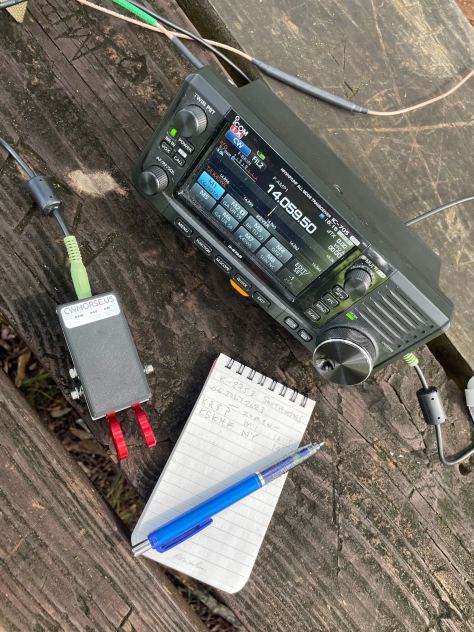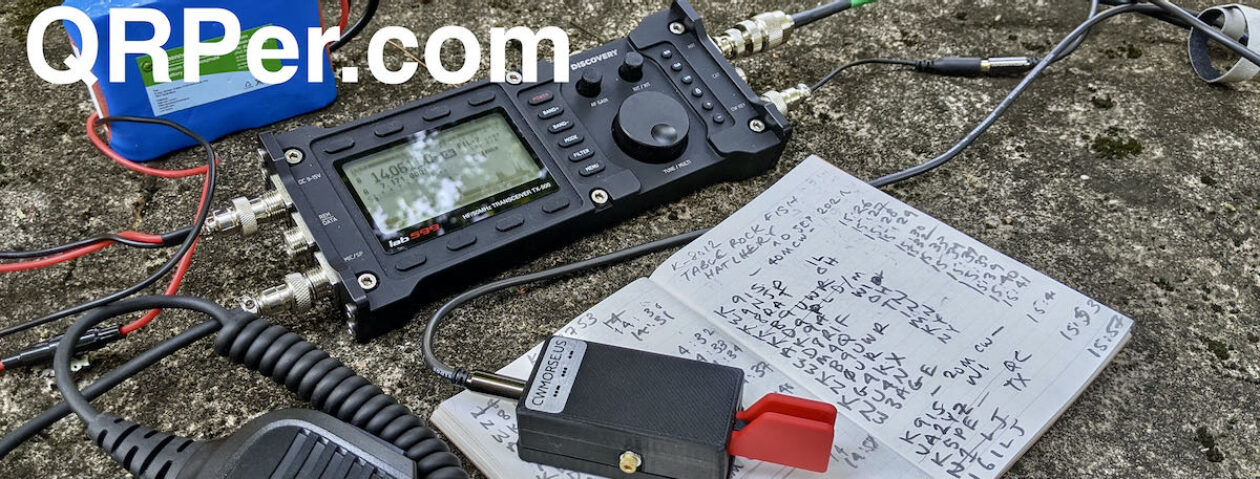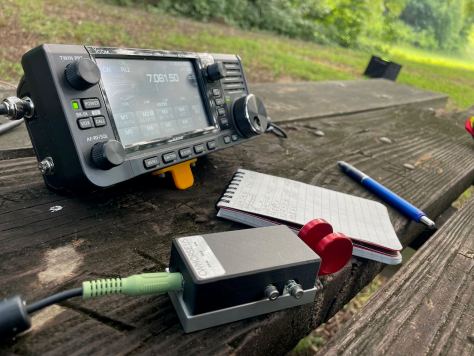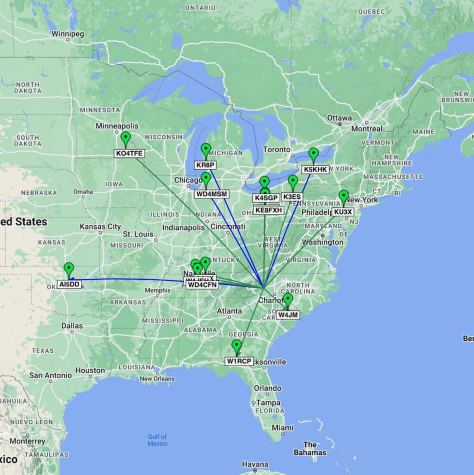I’m very fortunate in that over the past few years I’ve accumulated a number of QRP radios that I use in rotation when I do park and summit activations.
I’m often asked for advice on choosing radios, and as I’ve mentioned in the past, I feel like the decision is a very personal one–everything is based on an operator’s own particular preferences.
I’ve written formal reviews about most of the field radios in my collection over the years. In those reviews, I try to take a wide angle view of a radio–I try to see how it might appeal to a number of types of operators: field operators, DXers, summit activators, contesters, rag-chewers, casual operators, SWLs, travelers, outdoor adventurers, mobile operators, etc. I highlight the pros and cons, but I don’t focus on my own particular take because, again, my style of operating might not match that of readers. I try to present the full picture as clearly as I can and let the reader decide.
On that note, I thought it might be fun to take a radio out for a field activation and spend a bit of time explaining why I enjoy using that particular radio and why it’s a part of my permanent field radio collection. Instead of taking that wide-angle view of a radio like I do in magazine reviews, I share my own personal thoughts based on long-term experience.
Getting To Know You
 Each new video in the Getting To Know You series will highlight one of the field radios from my field radio collection. I’ll spend time in each video explaining what I personally appreciate about each radio, then we’ll do a park or summit activation with the radio.
Each new video in the Getting To Know You series will highlight one of the field radios from my field radio collection. I’ll spend time in each video explaining what I personally appreciate about each radio, then we’ll do a park or summit activation with the radio.
I’ll release these every few weeks or so–when the notion strikes me. They will not be on a regular schedule, but I hope to include each of my radios in this series over the the next year.
The Icom IC-705
The second radio in the Getting To Know You series is my Icom IC-705.
From the moment I first unboxed my Icom IC-705, I’ve been incredibly pleased with it. It’s a proper 21st century radio. Not only does it have a very wide frequency range, multimode operation, and an incredibly deep feature set, but it also sports proper wireless connectivity.
The IC-705 has become one of the most popular QRP rigs on the market despite it’s nearly $1,400 US price tag.
I originally purchased and reviewed the Icom IC-705 in 2020 (click here to read my review).
In the activation video (below) I’ll tell you about how I acquired my IC-705, why I think it’s so unique, and why I’ve no intention of ever selling it. Then, we’ll perform a POTA activation.
Keep in mind that my perspective will primarily focus on HF operating even though the IC-705 also sports multimode VHF and UHF.
South Mountains State Park (K-2753)
While driving back to the QTH on July 6, 2023, I stopped by the Clear Creek Access of South Mountains State Park–it was the perfect location to play radio on a hot and very humid day.
South Mountains’ only picnic table is located under the shade of a large oak tree.  When I first arrived at the table, though, I was disappointed to find a bunch of trash on the ground from someone who had obviously enjoyed a picnic meal along with about a pack of cigarettes.
When I first arrived at the table, though, I was disappointed to find a bunch of trash on the ground from someone who had obviously enjoyed a picnic meal along with about a pack of cigarettes.
Normally, I do a site check after the activation, grab a trash bag, and pick up any litter I find as I check the site for any gear I could have possibly dropped or left behind.
In this case, it was so bad, I did the clean-up prior to the activation.
For this activation, I decided to pair the IC-705 with my MM0OPX 40 meter End-Fed Half-Wave antenna.
In the activation video below, I show my ambitious attempts to deploy the antenna.
The tree above the picnic table is one of the easiest to launch a throw line into, but in this case I set a much higher goal for a much higher branch.
I couldn’t snag the “ideal” branch–it was just too high–but I did grab one that almost rivaled it!
If I’m being honest, it was awfully fun attempting that shot. Almost like going for a basketball goal from the other side of the court!
Gear:
 Note: All Amazon, CW Morse, Chelegance, eBay, and Radioddity links are affiliate links that support the QRPer.com at no cost to you.
Note: All Amazon, CW Morse, Chelegance, eBay, and Radioddity links are affiliate links that support the QRPer.com at no cost to you.
- Icom IC-705
- MM0OPX QRP EFHW (Contact Colin for Availability)
- Key cable: Cable Matters 2-Pack Gold-Plated Retractable Aux Cable – 2.5 Feet
- CW Morse CNC Machined Aluminum Paddle
- GoRuck GR1 USA
- Weaver arborist throw line/weight and Folding Arborist Throw Line Cube
- Zebra Mechanical Pencil, Del Guard, 0.7mm
- Rite In The Rain Top Spiral Notebook (small 3×5 size)
- Camera: original OSMO Action Camera (the OSMO 3 is the current version) with Sensyne Phone Tripod
On The Air
 I started calling CQ POTA on 20 meters and worked four contacts in four minutes. Very nice!
I started calling CQ POTA on 20 meters and worked four contacts in four minutes. Very nice!
Then there was a bit of a lull on 20 meters, so I moved to 40 meters. Note that since the EFHW antenna is resonant on 20, 15, 10, and 40, there was no need to do any sort of matching on either 40 or 20.
Forty meters was healthier. I worked an additional eleven contacts in 17 minutes for a total of 15 hunters logged.
What fun!
QSO Map
Here’s what this activation looked like when plotted out on a QSO Map.
Activation Video
Here’s my real-time, real-life video of the entire activation. As with all of my videos, I don’t edit out any parts of the on-air activation time. In addition, I have monetization turned off on YouTube, although that doesn’t stop them from inserting ads before and after my videos.
Note that Patreon supporters can watch and even download this video 100% ad-free through Vimeo on my Patreon page:
Click here to view on YouTube.
IC-705
 As I mention in the activation video, my intention when I purchased the IC-705 was to review it then sell it a few months later.
As I mention in the activation video, my intention when I purchased the IC-705 was to review it then sell it a few months later.
After I started taking the ‘705 to the field, though, I realized it would become a permanent member of my QRP radio family.
I love the audio, the filtering, the keying, and the versatility in terms of powering it. Sure, I use my KX2 more in the field, but I also do way more digital modes at the QTH with the IC-705 (using the excellent SDR-Control app) than I’ve ever done with any other radio. It’s so nice to have absolutely no cables connecting my radio to my laptop via the IC-705 hotspot.
Someday, we’ll take the IC-705 to the field for some FT8 POTA.
Thank you
 Thank you for joining me on this activation!
Thank you for joining me on this activation!
I hope you enjoyed the field report, Getting to Know You and activation portions of the video as much as I enjoyed creating them.
 Of course, I’d also like to send a special thanks to those of you who have been supporting the site and channel through Patreon and the Coffee Fund. While certainly not a requirement as my content will always be free, I really appreciate the support.
Of course, I’d also like to send a special thanks to those of you who have been supporting the site and channel through Patreon and the Coffee Fund. While certainly not a requirement as my content will always be free, I really appreciate the support.
As I mentioned before, the Patreon platform connected to Vimeo make it possible for me to share videos that are not only 100% ad-free, but also downloadable for offline viewing. The Vimeo account also serves as a third backup for my video files.
Thanks for spending part of your day with me!
Have a wonderful week!
Cheers & 72,
Thomas (K4SWL)










I am really enjoying this series. If you could include how the radios go for SWLing that would be good.
73
Andrew VK2ZRK
Thank you, Andrew!
I can’t remember how much I said about its SWL capabilities here, but in a nutshell: it is superb!
We’ve had many discussions about the IC-705 over on the SWLing Post.
Here’s a post that speaks to how brilliant of a broadcast receiver it is: https://swling.com/blog/2021/01/the-icom-ic-705-is-about-to-achieve-holy-grail-status/
Here’s my full review:
https://swling.com/blog/2021/03/a-review-of-the-icom-ic-705-qrp-portable-sdr-transceiver/?swcfpc=1
And here are all of the IC-705-tagged posts:
https://swling.com/blog/tag/ic-705/
In short, though, it’s a brilliant radio for SWLing.
Cheers,
Thomas
Another very happy IC-705 owner here. I use mine mostly on SOTA and POTA activations, mostly SSB and CW but I’ve also used it for FT8 and FT4 using an MS Surface Go 2 tablet and the RS-BA1 software. I also like trying VHF and UHF, usually FM and SSB but I’ve activated a couple of SOTA summits where I’ve used FM and SSB and then added CW and FT8 to make a four modes activation which was fun. The only cheating was I had prearranged for someone to be listening for me on 2m CW as it might have been a long wait to get a reply otherwise! On HF I’ve even had a QSO on AM with it from a SOTA summit. It doesn’t push out the full power on AM but if conditions are good it works.
The IC-705 really, is the Swiss Army knife of radios.
I have a 705 that I got shortly after they were released. I initially only used it with a chameleon magloop. I was amazed at how well the radio performed. I used the magloop in the QTH indoors with great success. Hawaii and AK on a magloop with 5 watts is pretty exciting. Made a move to FL and hurricane preparedness is the name of the game. One of the great features of the radio is the built in soundcard. This means you can run varaFM and winlink without an interface device. This also means that in the event of a catastrophe, that you can operate HF winlink too. I hear gripes about no internal tuner, but this really hasn’t been an issue for me as I put together HobbyPC’s most excellent “hardrock50” with the built in tuner. I also have the KPA100 and to a certain degree, the hardrock50 has more features than the more expensive KPA-100. But you know how hams are, the 705 is a great rig but I played with a KX3 and was blown away by how well the rig receives CW and the simple display harkens back to a simpler time of ham radio-not to mention, it is also much easier to read in sunlight. So, now I am on the Elecraft waitlist for a KX3. I’ve wondered if I would get rid of the 705, but I keep telling myself just how unique the rig is and how well it performs.
Glad to see you give a proper RST, 529, instead of the more common 229. If you can get the others call on the first try it should be 5×9,,, . Tnx es 73, Jim KI1H
I’ve had my IC-705 for a while now and like you, it is a part of my permanent collection. I recently purchased the SDR app for my iPhone and that makes the IC-705 so much more fun. I made a 3D face cover for the radio so I don’t have any of those cages either. You won’t find a more versatile radio.
I took my IC-705 to Aruba recently where it performed well. Being more distant with limited antennas the band scope is extremely helpful in assessing band conditions and finding stations to work. There’s an iPad app that supports the IC-705 called “SDR Control” that does FT8 and allows you to operate the IC-705 remotely over the Internet with a big beautiful display. When I traveled recently for business, I left the radio at home and still worked FT8 from my iPad. Enjoy! 73, Peter K1AV
Thomas,
Still waiting on a restock of the IC 705 DX says August 7th?
Lets hope!
After we spoke, the Lab 599 caught me eye. Good alternative, or keep waiting?
Tony KE8VFA
The Discovery TX-500 is a great radio, but not quite the same as the IC-705, of course. It all depends on your use case for it. I’m taking my TX-500 to the field this morning, in fact.
Based on our conversation, I do believe the IC-705 might still be your best choice.
August 7th is approaching quickly!
Cheers,
Thomas
Tony, I was pondering the same question a few months ago and decided to get the Lab 599 to start with the option to purchase the IC 705 if I found the Lab 599 lacking. My experience is that the 599 is an excellent radio for what it does. A bit of a learning curve to start with but preforms well. However, I want the other options that the 705 offers. Since I’m limited in my budget, I’ll be selling the Lab 599 (regrettably) and going for the 705 to gain the other options for digital modes in the field.
Ended up lucking out and getting a 705 from gigaparts.
Picked an LDG Z100 plus tuner from HRO. My set is coming together.
Looking at a few vertical antenna choices now.
I tend to change frequencies like a squirrel with ADD so a vertical antenna with a tuning coil is not for me. I am currently using a chemeleon product and it works very well. I use a trailer light wiring harness for my radial field-sometimes I use a lengthy piece of braid too. The thing I like about the vertical is that it is very easy to deploy and gives me coverage on 80-6m provided you have a tuner. I also have a zepp that I like, but it requires that I carry around a couple of supports for my installation as I don’t have large enough trees. If you like DX, the vertical is the way to go if you like NVIS, then check out the zepp. The Zepp is also very quiet too.
Do you use the 69 foot wire length recommended by Colin with your MM0OPX 40 meter End-Fed Half-Wave antenna, and when would you use a counterpoise with this specific antenna?
I know that an antenna analyzer helps identify appropriate antenna wire length, but I am just curious about your experience with this antenna.
Thank you very much.
Bill AG5ZN
Hi, Bill,
I think I started with something like 69′ and then simply trimmed it down to resonance on the CW portion of 40 meters. I didn’t measure what I trimmed off, though. I’d need to take a tape measure to the radiator on my MM0OPX EFHW to know for sure. If I can remember to do this when I’m back at the QTH, I will.
Cheers,
Thomas
Re counterpoise:
Normally you don’t need a counterpoise with and EFHW. Due to the skin effect a coax feed line is effectively 3 wires: the inner conductor, the inside of the shield, and the outside of the shield. The outside of the shield acts a counter poise as long as you don’t have a common mode choke too close to the feed point. At least that’s how I understand it. 73, Peter K1AV
Thanks so much.